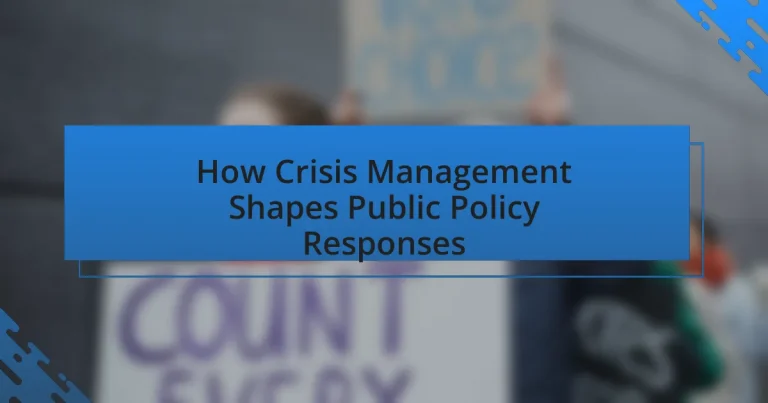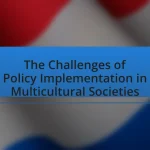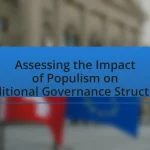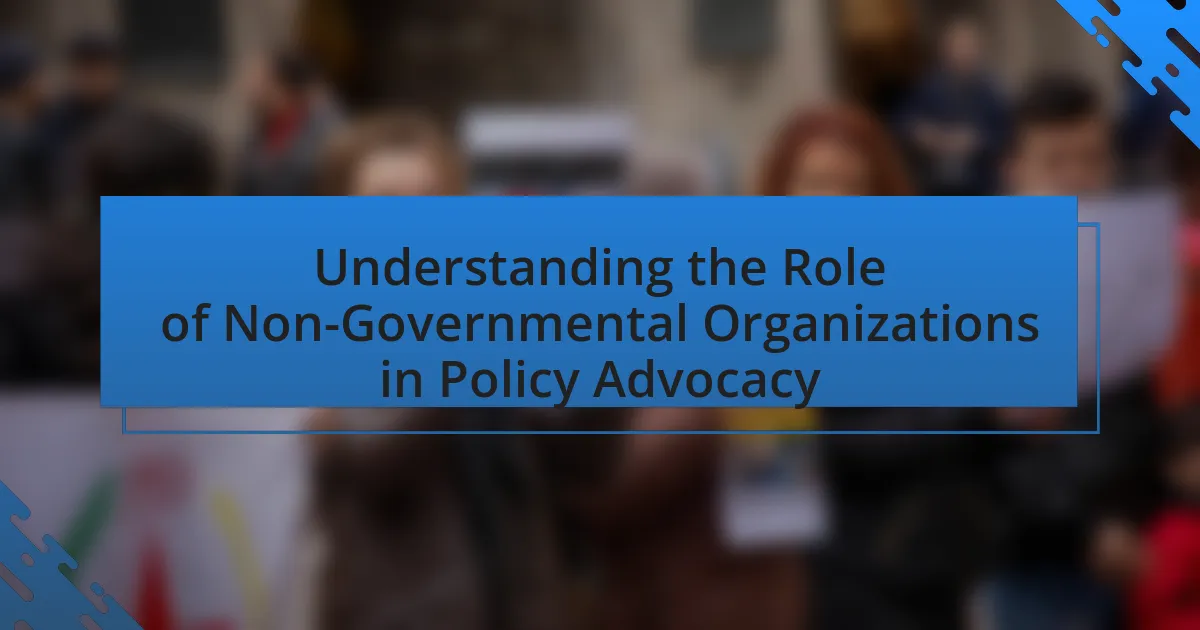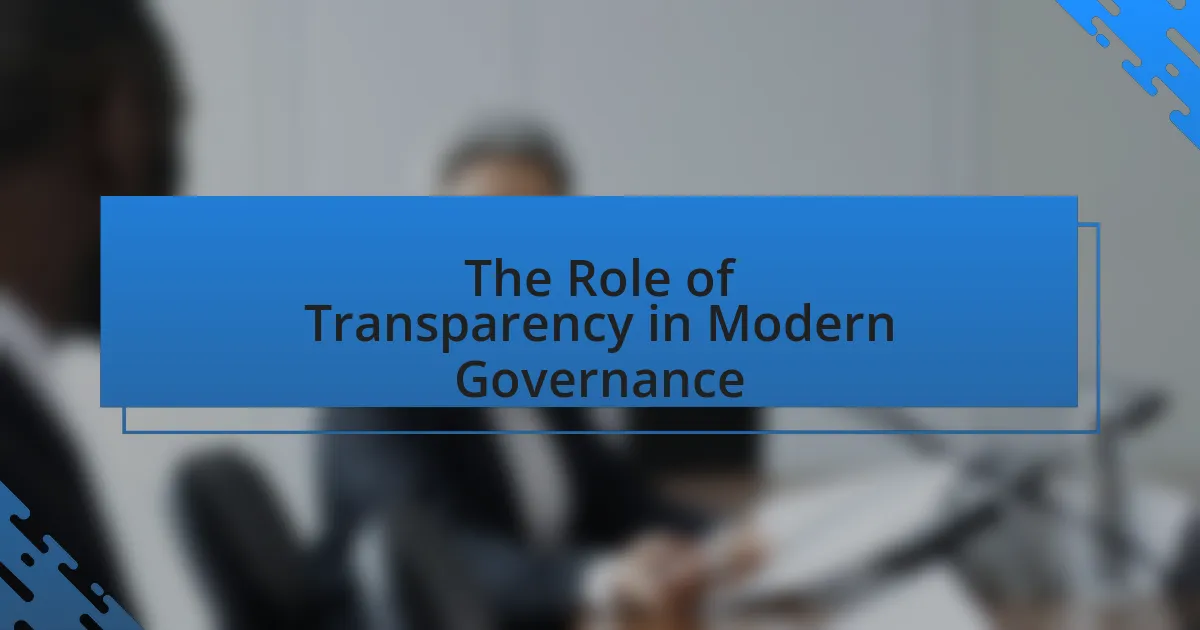Crisis management is a critical factor influencing public policy responses, particularly during emergencies that require swift decision-making and resource allocation. The article examines how effective crisis management principles—such as preparedness, communication, response, and recovery—shape policy formulation and implementation. It highlights the importance of clear communication and inter-agency collaboration in maintaining public trust and ensuring effective responses, as demonstrated through historical examples like the COVID-19 pandemic and Hurricane Katrina. Additionally, the article discusses the challenges faced in crisis management, including political factors, misinformation, and resource constraints, while emphasizing the need for continuous improvement and best practices to enhance future policy outcomes.
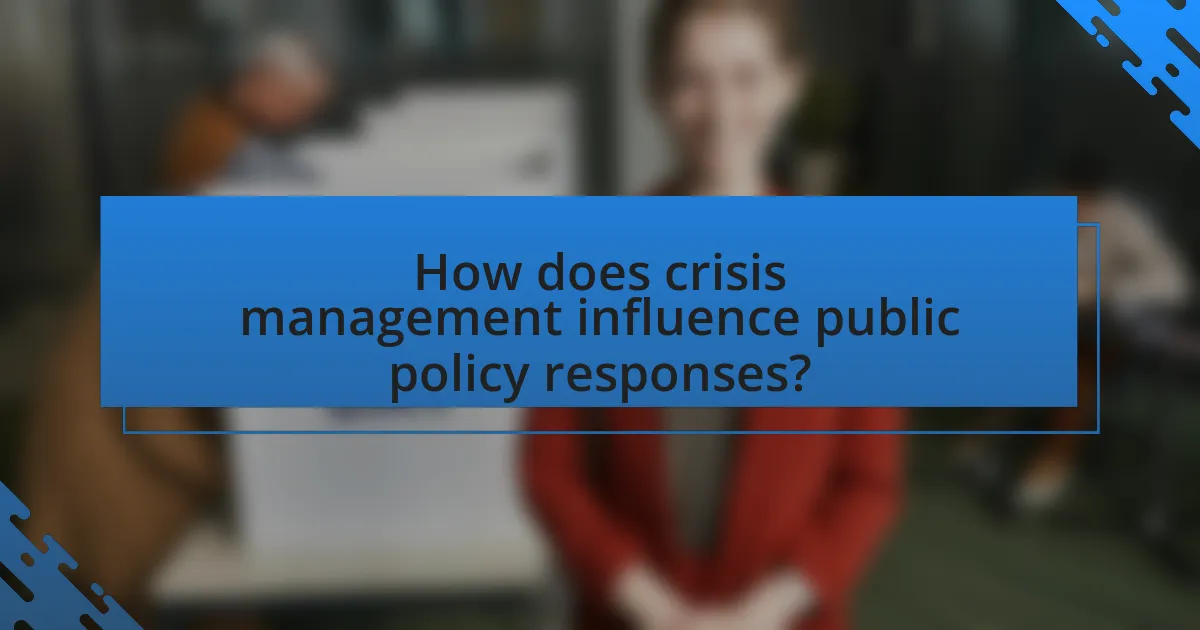
How does crisis management influence public policy responses?
Crisis management significantly influences public policy responses by necessitating rapid decision-making and resource allocation to address urgent issues. During crises, governments often implement policies that prioritize immediate public safety and welfare, as seen in the COVID-19 pandemic when many countries enacted emergency health measures and economic relief packages. These responses are shaped by the need for effective communication, coordination among agencies, and public trust, which are critical for successful crisis resolution. Historical examples, such as the response to natural disasters like Hurricane Katrina, illustrate how inadequate crisis management can lead to policy failures, prompting reforms in emergency preparedness and response strategies.
What are the key principles of crisis management?
The key principles of crisis management include preparedness, communication, response, and recovery. Preparedness involves developing plans and training to handle potential crises effectively. Communication ensures timely and accurate information dissemination to stakeholders, which is crucial for maintaining trust and managing public perception. The response principle focuses on executing the crisis plan efficiently to mitigate impacts, while recovery emphasizes restoring normalcy and learning from the crisis to improve future responses. These principles are supported by frameworks such as the Incident Command System, which outlines structured approaches to crisis situations, demonstrating their effectiveness in real-world applications.
How do these principles apply to public policy?
Crisis management principles apply to public policy by guiding decision-making processes during emergencies to ensure effective responses and resource allocation. These principles emphasize the importance of preparedness, communication, and collaboration among stakeholders, which are critical for formulating policies that address urgent societal needs. For instance, the Federal Emergency Management Agency (FEMA) utilizes these principles to develop policies that enhance community resilience and streamline disaster response efforts, as evidenced by the National Response Framework, which outlines coordinated actions among federal, state, and local agencies during crises.
What role does communication play in crisis management?
Communication is essential in crisis management as it facilitates the timely dissemination of information, helps manage public perception, and coordinates response efforts. Effective communication ensures that stakeholders, including the public, media, and emergency responders, receive accurate and consistent information, which is crucial for maintaining trust and reducing panic during a crisis. For instance, during the COVID-19 pandemic, clear communication from health authorities about safety measures and updates significantly influenced public compliance and behavior, demonstrating how strategic messaging can shape responses and outcomes in crisis situations.
Why is effective crisis management crucial for public policy?
Effective crisis management is crucial for public policy because it enables governments to respond swiftly and effectively to emergencies, minimizing harm and restoring order. When crises occur, such as natural disasters or public health emergencies, effective management ensures that resources are allocated efficiently, communication is clear, and public trust is maintained. For instance, during the COVID-19 pandemic, countries with robust crisis management frameworks, like New Zealand, implemented timely lockdowns and clear communication strategies, resulting in lower infection rates and quicker recovery. This demonstrates that effective crisis management not only addresses immediate threats but also shapes long-term public policy by establishing frameworks for future responses and enhancing resilience in governance.
What are the potential consequences of poor crisis management?
Poor crisis management can lead to severe consequences, including loss of public trust, economic downturns, and increased social unrest. When organizations or governments fail to effectively manage a crisis, they risk alienating stakeholders and the general public, which can result in long-term reputational damage. For instance, the mishandling of the COVID-19 pandemic response in various countries led to widespread criticism and diminished confidence in public health authorities. Economically, poor crisis management can disrupt supply chains and lead to financial losses; the 2008 financial crisis exemplified how inadequate regulatory responses can precipitate global economic instability. Additionally, ineffective communication during a crisis can exacerbate fear and confusion, leading to protests or civil disorder, as seen in various social movements that arose from perceived governmental failures.
How can crisis management improve public trust in policy decisions?
Crisis management can improve public trust in policy decisions by demonstrating transparency and responsiveness during emergencies. Effective crisis management involves clear communication, timely updates, and active engagement with the public, which fosters a sense of reliability and accountability. For instance, during the COVID-19 pandemic, governments that provided regular briefings and openly shared data on infection rates and policy changes were able to maintain higher levels of public trust compared to those that were less transparent. Research from the Pew Research Center indicates that transparency in government actions significantly correlates with increased public confidence in policy decisions.
What are the stages of crisis management in relation to public policy?
The stages of crisis management in relation to public policy include prevention, preparedness, response, recovery, and mitigation. Prevention involves identifying potential crises and implementing measures to avoid them, such as policy reforms or regulations. Preparedness focuses on planning and training to ensure effective responses, often involving simulations and stakeholder engagement. Response is the immediate action taken to address the crisis, which may include emergency declarations and resource mobilization. Recovery encompasses the actions taken to restore normalcy and rebuild, often requiring policy adjustments and funding allocations. Finally, mitigation aims to reduce the impact of future crises through long-term strategies and policy changes. These stages are critical as they guide public officials in developing effective policies that enhance resilience and improve outcomes during crises.
How does the preparation phase impact policy responses?
The preparation phase significantly impacts policy responses by establishing frameworks and protocols that guide decision-making during crises. Effective preparation enables policymakers to anticipate potential challenges and allocate resources efficiently, which leads to timely and coordinated responses. For instance, the Federal Emergency Management Agency (FEMA) emphasizes the importance of preparedness in its National Response Framework, which outlines roles and responsibilities for various stakeholders during emergencies. This structured approach ensures that when a crisis occurs, the groundwork laid during the preparation phase facilitates rapid mobilization of resources and clear communication, ultimately improving the effectiveness of the policy response.
What actions are taken during the response phase?
During the response phase, organizations implement immediate actions to address the crisis effectively. These actions typically include mobilizing emergency response teams, coordinating with relevant agencies, communicating with stakeholders, and deploying resources to mitigate the impact of the crisis. For instance, during natural disasters, emergency services are activated to provide aid, while public information campaigns are launched to keep the public informed about safety measures. These actions are crucial for minimizing harm and restoring order, as evidenced by the structured response protocols established by agencies like FEMA in the United States, which outline specific steps to be taken during various types of crises.
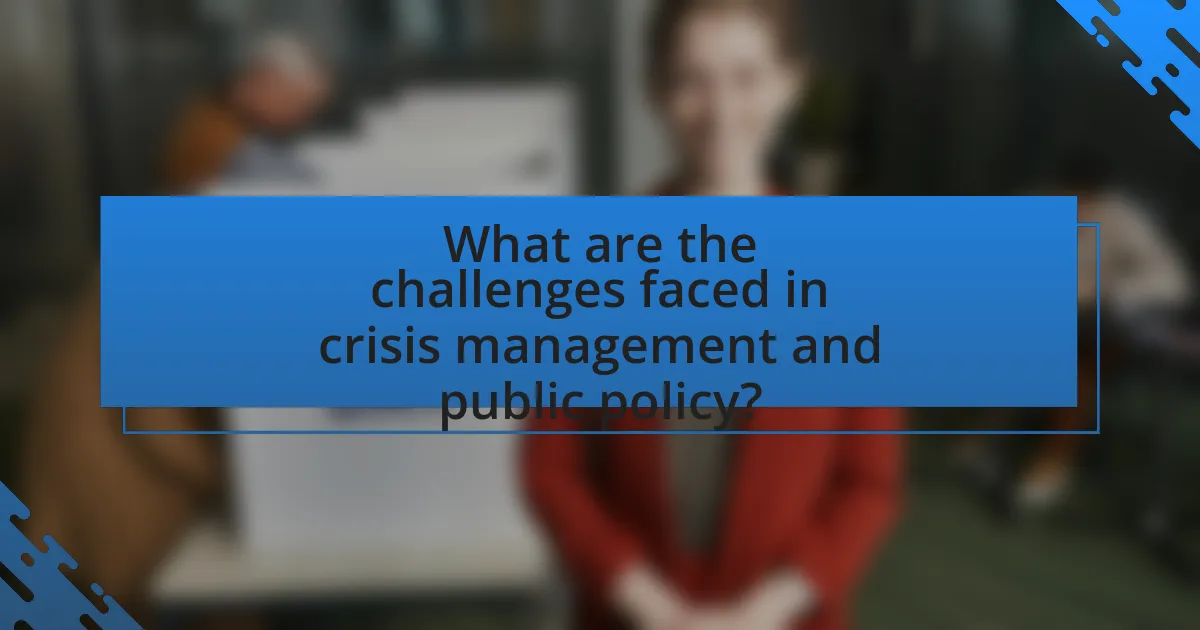
What are the challenges faced in crisis management and public policy?
Crisis management and public policy face several challenges, including coordination among agencies, communication breakdowns, and resource allocation issues. Coordination among various governmental and non-governmental organizations is often hindered by differing priorities and bureaucratic red tape, which can delay response efforts. Communication breakdowns can lead to misinformation and public distrust, as seen during the COVID-19 pandemic when inconsistent messaging created confusion. Additionally, resource allocation issues arise when limited funding and personnel are stretched thin, impacting the effectiveness of response strategies. These challenges highlight the complexities involved in effectively managing crises and formulating responsive public policies.
How do political factors affect crisis management strategies?
Political factors significantly influence crisis management strategies by shaping decision-making processes, resource allocation, and public communication. For instance, during the COVID-19 pandemic, government responses varied widely based on political ideologies, with some administrations prioritizing public health measures while others focused on economic impacts. This divergence illustrates how political leadership and party affiliation can dictate the urgency and nature of crisis responses. Additionally, political stability affects the effectiveness of crisis management; countries with stable governments tend to implement more cohesive and timely strategies, as seen in Germany’s structured response compared to less coordinated efforts in politically unstable regions.
What are the implications of political agendas on policy responses?
Political agendas significantly influence policy responses by prioritizing certain issues over others, which can lead to selective resource allocation and varying levels of urgency in addressing societal needs. For instance, during the COVID-19 pandemic, governments with strong public health agendas implemented swift lockdowns and extensive testing, while those with less emphasis on health faced criticism for delayed responses. This demonstrates that the alignment of political priorities with public needs directly affects the effectiveness and timeliness of policy measures. Furthermore, research by the Brookings Institution highlights that political motivations can skew policy outcomes, often favoring short-term gains over long-term solutions, thereby impacting overall governance and public trust.
How can partisanship hinder effective crisis management?
Partisanship can hinder effective crisis management by creating divisions that obstruct collaboration and consensus among stakeholders. When political parties prioritize their interests over collective action, it leads to delays in decision-making and implementation of necessary measures. For instance, during the COVID-19 pandemic, partisan disagreements over public health policies resulted in inconsistent messaging and responses across states, undermining the overall effectiveness of crisis management efforts. This lack of unity can exacerbate the crisis, as seen in the varied approaches to lockdowns and vaccine distribution, ultimately impacting public trust and compliance.
What role does public perception play in crisis management?
Public perception plays a critical role in crisis management by influencing decision-making and shaping responses to crises. When the public perceives a crisis as severe, it can lead to increased pressure on organizations and governments to act swiftly and transparently. For instance, during the COVID-19 pandemic, public concern about health and safety prompted governments worldwide to implement strict measures, demonstrating how public sentiment can drive policy changes. Additionally, research indicates that effective communication during a crisis can enhance public trust, which is essential for compliance with emergency measures. Therefore, understanding and addressing public perception is vital for successful crisis management and effective public policy responses.
How can misinformation impact public policy responses?
Misinformation can significantly distort public policy responses by leading to misguided decisions based on false narratives. For instance, during the COVID-19 pandemic, misinformation regarding the virus’s transmission and treatment influenced government actions, resulting in delayed responses and ineffective measures. A study published in the journal “Health Affairs” found that misinformation contributed to public confusion, which in turn affected compliance with health guidelines and policies. This demonstrates that when policymakers rely on inaccurate information, the effectiveness of their responses can be severely compromised, ultimately impacting public health and safety.
What strategies can mitigate negative public perception during a crisis?
Effective strategies to mitigate negative public perception during a crisis include transparent communication, timely updates, and proactive engagement with stakeholders. Transparent communication fosters trust, as seen in the 2014 Ebola outbreak, where the Centers for Disease Control and Prevention (CDC) provided regular updates, which helped to alleviate public fears. Timely updates ensure that the public receives accurate information, reducing the spread of misinformation; for instance, during the COVID-19 pandemic, countries that communicated regularly about health measures experienced less public panic. Proactive engagement with stakeholders, including community leaders and media, allows organizations to address concerns directly and build a supportive narrative, as demonstrated by companies that successfully navigated crises by involving local communities in their response efforts.
What are the limitations of current crisis management frameworks?
Current crisis management frameworks often lack adaptability, leading to ineffective responses in dynamic situations. These frameworks typically rely on predefined protocols that may not account for the unique aspects of each crisis, resulting in a one-size-fits-all approach. For instance, during the COVID-19 pandemic, many existing frameworks struggled to address the rapid changes in information and public behavior, highlighting their rigidity. Additionally, current frameworks frequently fail to integrate real-time data and stakeholder input, which are crucial for informed decision-making. This limitation can lead to delayed responses and misallocation of resources, as seen in various natural disasters where local knowledge was overlooked.
How do resource constraints affect crisis response efforts?
Resource constraints significantly hinder crisis response efforts by limiting the availability of essential supplies, personnel, and funding. When resources are scarce, response teams may struggle to mobilize effectively, leading to delayed interventions and inadequate support for affected populations. For instance, during the COVID-19 pandemic, many healthcare systems faced overwhelming demand with insufficient medical supplies and personnel, which resulted in increased mortality rates and prolonged recovery times. This illustrates that without adequate resources, the ability to respond swiftly and effectively to crises is severely compromised, ultimately impacting public health outcomes and recovery efforts.
What gaps exist in training and preparedness for crisis management?
Gaps in training and preparedness for crisis management include insufficient simulation exercises, lack of interdisciplinary collaboration, and inadequate focus on emerging threats. Research indicates that many organizations do not conduct realistic drills that mimic actual crisis scenarios, which limits their ability to respond effectively. Additionally, crisis management often lacks input from diverse fields such as public health, cybersecurity, and environmental science, leading to fragmented responses. Furthermore, training programs frequently overlook new and evolving threats, such as pandemics or cyberattacks, which can leave organizations unprepared for contemporary challenges.
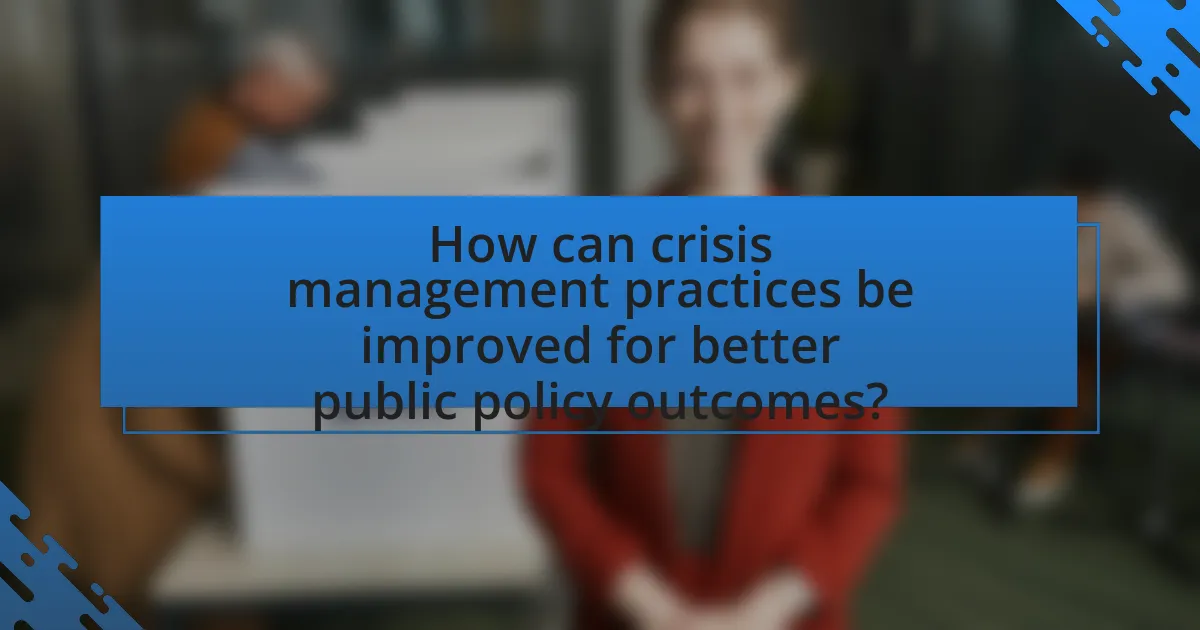
How can crisis management practices be improved for better public policy outcomes?
Crisis management practices can be improved for better public policy outcomes by enhancing communication strategies and fostering collaboration among stakeholders. Effective communication ensures that accurate information is disseminated promptly, reducing misinformation and panic during crises. For instance, the COVID-19 pandemic highlighted the importance of clear messaging from health authorities, which significantly influenced public compliance with health guidelines. Additionally, collaboration among government agencies, non-profits, and the private sector can lead to more comprehensive and coordinated responses, as seen in successful disaster recovery efforts like Hurricane Katrina, where multi-agency collaboration improved resource allocation and response times. These improvements in communication and collaboration directly contribute to more effective public policy outcomes during crises.
What best practices can enhance crisis management effectiveness?
Effective crisis management can be enhanced through clear communication, proactive planning, and stakeholder engagement. Clear communication ensures that accurate information is disseminated quickly, reducing misinformation and panic; for instance, during the COVID-19 pandemic, timely updates from health authorities helped manage public response. Proactive planning involves developing crisis response plans that include risk assessments and resource allocation, which can significantly improve response times and effectiveness, as evidenced by organizations that conducted regular drills and simulations. Stakeholder engagement fosters collaboration among government agencies, private sectors, and communities, leading to a more coordinated response, as seen in successful disaster management efforts like Hurricane Katrina, where community involvement was crucial for recovery.
How can collaboration between agencies improve policy responses?
Collaboration between agencies can significantly improve policy responses by enhancing information sharing, resource allocation, and coordinated action. When agencies work together, they can pool their expertise and data, leading to more informed decision-making and comprehensive strategies. For instance, during public health crises, collaboration between health departments, emergency services, and local governments has been shown to streamline response efforts, as evidenced by the coordinated response to the COVID-19 pandemic, where multi-agency collaboration facilitated rapid testing and vaccination rollouts. This synergy not only increases efficiency but also fosters trust among stakeholders, ultimately resulting in more effective and timely policy implementations.
What role does technology play in modern crisis management?
Technology plays a crucial role in modern crisis management by enhancing communication, data analysis, and resource allocation. It enables real-time information sharing among stakeholders, which is vital for effective decision-making during crises. For instance, the use of social media platforms allows organizations to disseminate critical updates quickly, while data analytics tools help identify patterns and predict potential outcomes, as seen during the COVID-19 pandemic where data-driven models informed public health responses. Furthermore, technologies such as Geographic Information Systems (GIS) facilitate efficient resource distribution and logistical planning, proving essential in disaster response scenarios.
How can lessons learned from past crises inform future policy?
Lessons learned from past crises can inform future policy by providing evidence-based insights into effective response strategies and highlighting areas for improvement. For instance, the COVID-19 pandemic revealed the importance of rapid testing and contact tracing, which can guide future health policies to enhance preparedness for similar outbreaks. Historical data from the 2008 financial crisis demonstrated the necessity of regulatory frameworks to prevent systemic risks, influencing contemporary financial policies aimed at safeguarding economic stability. By analyzing these past events, policymakers can develop more resilient frameworks that address vulnerabilities and enhance overall societal resilience.
What case studies illustrate successful crisis management in public policy?
Successful crisis management in public policy is illustrated by the case studies of the 2003 SARS outbreak in Canada and the 2010 BP oil spill in the Gulf of Mexico. During the SARS outbreak, the Canadian government implemented effective public health measures, including quarantine protocols and transparent communication, which led to a swift containment of the virus and restoration of public confidence. This response is supported by the World Health Organization’s assessment that Canada effectively controlled the outbreak through coordinated efforts. In the case of the BP oil spill, the U.S. government’s rapid mobilization of resources, establishment of the Deepwater Horizon Response Unified Command, and engagement with local communities demonstrated effective crisis management. The National Commission on the BP Deepwater Horizon Oil Spill and Offshore Drilling highlighted the importance of these actions in mitigating environmental damage and restoring public trust in regulatory agencies.
How can continuous improvement be integrated into crisis management practices?
Continuous improvement can be integrated into crisis management practices by establishing a systematic approach that incorporates feedback loops, regular assessments, and adaptive strategies. This integration allows organizations to learn from past crises, refine their response protocols, and enhance overall resilience. For instance, after a crisis, conducting thorough debriefs and analyzing response effectiveness can identify areas for improvement, leading to updated training programs and resource allocation. Research indicates that organizations employing continuous improvement methodologies, such as Plan-Do-Check-Act (PDCA), demonstrate greater adaptability and effectiveness in crisis situations, as evidenced by case studies in disaster response where iterative learning led to improved outcomes.
What practical steps can policymakers take to strengthen crisis management?
Policymakers can strengthen crisis management by implementing comprehensive training programs for emergency responders. These programs should focus on real-world scenarios, enhancing decision-making skills under pressure, and fostering inter-agency collaboration. Evidence from the Federal Emergency Management Agency (FEMA) indicates that jurisdictions with regular training exercises experience 30% faster response times during crises. Additionally, establishing clear communication protocols ensures that information flows efficiently among stakeholders, which is crucial during emergencies. Research from the National Academy of Sciences highlights that effective communication can reduce public panic and misinformation, thereby improving overall crisis outcomes.
